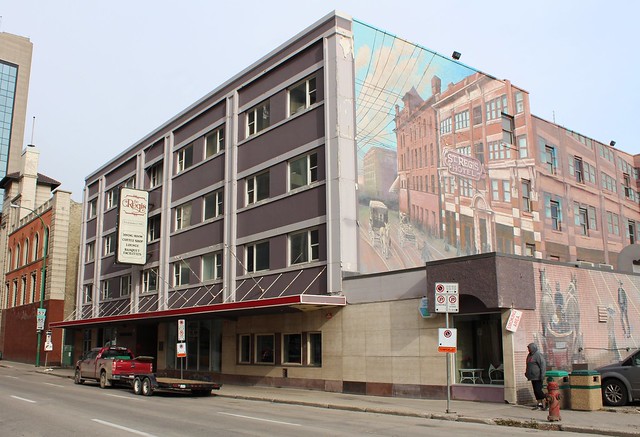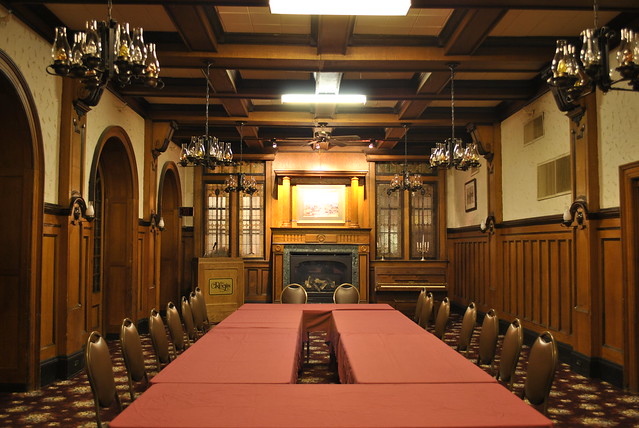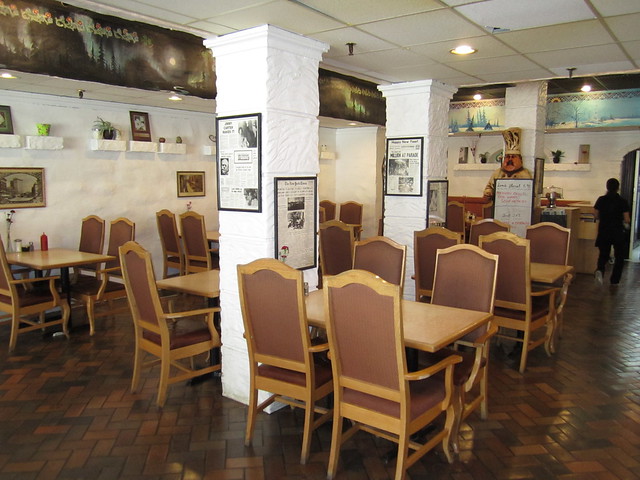© 2012, 2017 Christian Cassidy
Address: 285 Smith Street (Map)
Opened: July 12, 1911
Architect: H. G. Holman
July 11, 1911, Manitoba Free Press
The St. Regis Hotel was a partnership between two of early Winnipeg's more prominent hoteliers.
Charles “Charlie” McCarrey owned the Inter Ocean Hotel on Main Street at Notre Dame since 1906 and opened the St. Charles Hotel in 1912. John “Jack” Lee came to Manitoba in 1905 and was was the front-man for a consortium that specialized in rescuing failing hotels or building news ones and flipping them to new owners when construction was complete.
Lee was the splashier of the two partners, owning a professional hockey team called the Maple Leafs, (named after one of his hotels). He also owned thoroughbred racehorses, eventually amassing a stable of more than 20, said to be the largest in the city at the time.
Manitoba Free Press, November 2, 1909
The building at 285 Smith actually dates back to 1909 -1910 and was called the Rookery Block, a two-storey building with retail on the main floor and small residential suites above. Construction began in 1909, but thanks to a brutally cold winter, work fell behind schedule and the building did not open until summer 1910.Barely a year after opening, tenants of the Rookery received notice to vacate so that the building could be converted into the St. Regis Hotel.
St. Regis ca. 1926. Source
McCarrey and Lee hired architect H. G. Holman to design a $100,000 expansion to the building which included the addition of two floors. The St. Regis' rooms would have all of mod-cons expected of a luxury hotel in a modestly-priced establishment including hot and cold running water, en-suite lavatories, telephones, electric lighting and carpeting throughout.
The hotel also had large and small "sample rooms" for rent. These were spaces where travelling salesmen staying at the hotel could set up their wares.
The St. Regis was barely launched when McCarrey and Lee took over the LeClaire, (now Windsor) , Hotel and began a major renovation there. Also in 1912, McCarrey partnered in the construction of the St. Charles Hotel and Lee expanded his hotel interests into rural Manitoba and Saskatchewan.
Regina Morning Leader, April 7, 1916
Prohibition came to Manitoba in March 1916 and brought down many hoteliers who relied heavily on the sales from the bar to keep their businesses afloat.
Initially, Lee, whose name appeared on the licence, defied the law and openly served alcohol for another couple of weeks. After incurring a number of fines and under threat of a prison sentence for his next offence he closed the St. Regis' bar in style.
Drinks were given away and when the party atmosphere reached its peak, kegs of beer were opened onto Smith Street while fireworks were set off from the roof! (See the above article for more details.)
Lee stayed around Winnipeg for another few years. In 1919, he took over the lease of the defunct Olympia Hotel that had been used as a troop hostel during the war. Later that year he sold it to new owners who added six stories and rechristened it The Marlborough. Soon after, Lee retired to California where he died in 1939.
McCarrey continued to manage the St. Regis until 1919 when he got out of the local hotel business and moved to Montreal.
As with most hotels, it was their restaurants that set their tone.
McCarrey and Lee appear to have opted for fine dining over entertainment. Paris-trained chef Vincent Berniot ran the 130-seat Grill Room restaurant there was also a Louis XVI cafe, both decorated in a "moorish motif". An informal coffee shop and a lounge rounded out the main floor dining options.
In 1931, all four of the spaces were leased out to John McLeod, the former general manager of the restaurant division of HBC. He made extensive renovations to the spaces and reopened them as McLeod's Restaurants. The dining room was for high end dining, while the cafe offered a coffee shop atmosphere up front, with a more formal eating area in the back.
For whatever reason, the venture did not last long and in 1933 McLeod's was gone.
He was an original partner in the business as it was his livery stables that were bought out to build The Rookery / St. Regis in 1909. Along with cash, he also got shares in the company.
Known well Manitoba horse breeding circles, in 1918 he moved into the hotel and was its manager from 1923 to 1929. He then sold his shares but continued to live at the hotel until his death in 1936.
He was succeeded by Dee Reade who was replaced in 1936 by R. M. Deyell, formerly the chief clerk at the Banff Springs Hotel.
March 1940 ad, Winnipeg Tribune
The St. Regis had a long-standing connection to the airline industry.
In 1937, Skylines Express, a regional airline serving the mining areas of eastern Manitoba and Northwest Ontario, set a ticket and cargo office there for a couple of years.
During World War II, room 234 was the office of the Virden Flying Club, instructors for the No. 19 Elementary Flying Training School (EFTS).
In 1940, James Richardson's Canadian Airways Ltd. opened an office at the St. Regis. It was a more convenient place for customers to get schedule and fare information and to drop off cargo than going all the way out to the airport.
In 1947, Central Northern Airways, (which went on to become Transair), opened a similar type of office at the hotel, though by that time Canadian Airways had moved on.
1949 ad, Winnipeg Tribune
The St. Regis' attention to its restaurants made it hugely popular as a place for luncheons and banquets for social service clubs, sports leagues and business associations. Groups ranging from the 78th Battalion Association to the Good Roads Association and the Manitoba Beekeepers' Association held their annual dinners there for many years.
Countless anniversaries, retirement parties and wedding receptions were celebrated there.
Top: 1950s postcard
Bottom: November 26, 1957, Winnipeg Tribune
Another major renovation took place in 1956 - 57 under general manager William McIntosh. This time, the restaurants were back.
They included an open kitchen, lunch counter style restaurant, the Oak Room, The Forest Room and the Wedgwood.
The hotel had always been owned by a company so there was no single owner, just the president of the company. In the late 60s and early 70s the ownership group was called Mutual Investments Ltd., which included Paul N. Duval as president and Lieutenant Governor Jack McKeag.
It was during this period, 1969 to 1972, that the hotel underwent another major renovation in advance of the Winnipeg Convention Centre's opening.
It was overseen by general manager Harvey Weibe who joined the hotel's management team in 1968 before getting the top job in 1970. He stayed until the end of the renovations, then went on to become the GM o f the Charter House Hotel. Johann Hermans succeeded him.
Postcard circa 1970s
During this same period, though, a number of new high-rise hotels were also built downtown in anticipation of the Convention Centre. As a result, the fortunes of many aging, non-chain hotels began to suffer and the St. Regis was no different.
Through the 1990s and early 2000s the St. Regis and its Embassy Lounge got a reputation as a violent place, the scene of stabbings and a pair of murders in the vicinity.
CentreVenture, the city's development agency, saw the hotel as an impediment to attracting upscale bars and restaurants to the area, its main mission since the return of the Winnipeg Jets. In 2012 they purchased the hotel and announced that the following year the bar would be closed.
In 2015, CentreVenture sold the property to Fortress Real Developments for $4 million so that it may become a parkade space for the proposed SkyCity Centre development.
The 5,600 square foot mural on the south wall of the hotel depicting its original facade added in 2003 by artist Charlie Johnston.
My St. Regis Hotel Photo Gallery
CentreVenture Gives Fortress Another Year CBC (May 2017)
CentreVenture Purchases St. Regis Hotel CentreVenture (Nov 2012)
CentreVenture buys downtown Winnipeg Hotel CBC (Nov 2012)
CentreVenture buys St. Regis Hotel Winnipeg Free Press (Nov 2012)
St. Regis Hotel Sold Winnipeg Free Press, May 27, 2015 (May 2015)
The Oak Room
Items in curio case, front lobby
Pierre Trudeau at St. Regis, 1970s
December 1911 ad, Winnipeg Tribune
Mrs. Parnell, waitress, Sept. 1941, Winnipeg Tribune
April 1918 ad, Winnipeg Tribune






















When I came out of the closet in 1977 the St. Regis was a semi safe space for "homosexuals' to gather for drinks. This was when beverage rooms closed at diner time so the men would go home to their wives. Not having wives many of us would cross the street to the Silver Slipper lounge in the Northstar Inn which had a lounge license and stayed open through dinnertime
ReplyDeleteI recall the St. Regis was a place when many progressive conservative politicians met on a regular basis. Would be interested in hearing any comments on this.
ReplyDeleteChristopher Adams adamsc@umanitoba.ca
A beautiful hotel turned dump. Same thing happened to the Marlborough Inn.
ReplyDelete